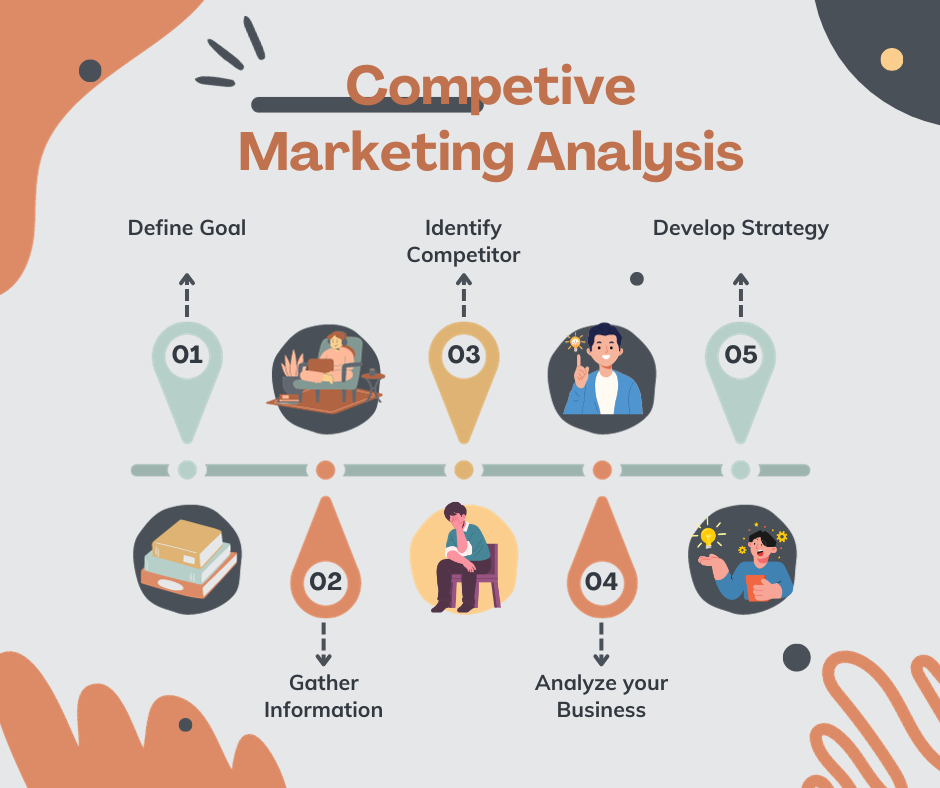In the ever-evolving world of business, staying ahead of the competition, and competitive marketing analysis is essential for success. A comprehensive competitive marketing analysis is your roadmap to understanding your industry, identifying your competitors, and gaining insights that will help you craft a winning content, design, marketing, and SEO strategy. In this blog post, we’ll provide a step-by-step guide on how to conduct a thorough competitive marketing analysis to give your business a competitive edge.

Define Your Goals and Objectives
Before you dive into competitive analysis, it’s essential to establish clear goals and objectives. What are you looking to achieve through this analysis? Are you interested in market positioning, product development, pricing, or marketing strategies? Define your focus areas to guide your research effectively.
Identify Your Competitors
Begin by identifying your direct and indirect competitors. Direct competitors offer similar products or services to the same target audience, while indirect competitors may offer different solutions to the same customer problems. Sources for identifying competitors includes:
- Market research reports
- Industry publications
- Online searches
- Customer feedback and reviews
- Social media monitoring Make a list of your competitors, ranking them by factors like market share, size, and relevance to your business.
Gather Information
In this step, you collect information about your competitors, focusing on various aspects of their business. Key areas to investigate include:
- Product or Service Offering: Understand the range and quality of their products or services. What unique features do they offer?
- Pricing Strategies: Analyze their pricing structures and any discounts, promotions, or loyalty programs they have in place.
- Market Positioning: Identify how competitors position themselves in the market. Do they emphasize quality, price, convenience, or other factors?
- Target Audience: Determine who their primary and secondary target demographics are.
- Marketing Strategies: Explore their marketing channels, content, and campaigns. Pay attention to their branding, messaging, and advertising efforts.
- Online Presence: Study their websites, social media profiles, and customer reviews. Analyze their website’s user experience and navigation.
- Customer Reviews and Feedback: Analyze what customers are saying about your competitors. Pay attention to both positive and negative feedback.
- SWOT Analysis: Conduct a SWOT (Strengths, Weaknesses, Opportunities, and Threats) analysis for each competitor to assess their current standing in the market.
Analyze Your Business
- Competitive Matrix and Benchmarking Create a competitive matrix that visually compares your business with your competitors on various parameters, such as price, quality, marketing strategies, and market share. This matrix helps you identify areas where your business outperforms competitors and areas that need improvement.
- Analyze Market Trends and Industry Insights To stay ahead of the curve, it’s crucial to analyze market trends and industry insights. Subscribe to industry publications, join relevant forums or associations, and attend conferences or webinars. This knowledge will help you understand how your industry is evolving and what innovations and strategies your competitors are likely to adopt.
- Customer Surveys and Feedback Engage with your customers to gather valuable insights about your competitors. Conduct surveys or interviews to understand why customers choose your competitors, what they like about their offerings, and what they dislike. Use this information to fine-tune your strategies.
- SWOT Analysis for Your Business After gathering extensive information about your competitors, it’s time to perform a SWOT analysis for your own business. This self-assessment helps you identify your strengths, weaknesses, opportunities, and threats in relation to your competitors. The goal is to leverage your strengths, address your weaknesses, seize opportunities, and mitigate threats.
Develop a Competitive Strategy
Armed with all the insights you’ve gathered, it’s time to develop a competitive marketing strategy. This strategy should address the following:
- How you plan to differentiate your business from competitors.
- What marketing channels and tactics will you use to reach and engage your target audience?
- How you will leverage your strengths to your advantage.
- How you will address weaknesses and mitigate threats. Your competitive strategy should guide your marketing efforts and align with your overall business objectives.
- Regular Monitoring and Adaptation Competitive analysis is not a one-time endeavor; it’s an ongoing process. Continuously monitor your competitors, industry trends, and customer feedback. Adapt your strategies as needed to maintain your competitive edge.
Conclusion
A thorough competitive marketing analysis is a fundamental step in understanding your market, identifying opportunities, and developing a strategy to outperform your competitors. By defining your goals, gathering information, conducting a SWOT analysis, and creating a competitive strategy, you’ll be well-equipped to make informed decisions that will drive the success of your business. Remember that staying competitive is not about imitating your rivals, but about leveraging your strengths and distinctive qualities to stand out in the market.
